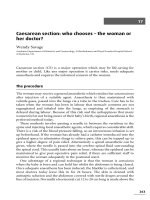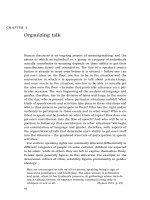pretty woman vs pillow talk
Bạn đang xem bản rút gọn của tài liệu. Xem và tải ngay bản đầy đủ của tài liệu tại đây (38.8 KB, 2 trang )
Pretty Woman Vs. Pillow Talk
The marriage plot has been quite prominent in the film industry over the
past few decades. The plot that is characterized by its lead woman
“getting” the lead man and vice versa, has contributed to such movie
blockbusters as Pretty Woman and the classic film, Pillow Talk. While
both films can be classifies as containing marriage plots, the films share
other similarities as well. However, in regards to the marriage plot,
Pretty Woman follows the pattern much more fluently and precisely that
does Pillow Talk. Both Julia Robert’s and Doris Day’s characters, Vivian
and Jan, respectively, are strong women in their films. They both contain
quite a few characteristics such as boldness, confidence, and intelligence
that make them very attractive and desirable to their male counterparts.
While their professions are quite opposite, the women are similar in their
personalities. Jan is an interior designer and her history with men is not
troublesome or lacking, but like Vivian, the prostitute, she finds that men
are sometimes after only one thing. I noticed that both women are
extremely confident when it comes to dealing with men; they both know
what they want and what the are looking for in a male companion.
The men in these two movies are quite similar as well. Both Rock
Hudson and Richard Gere play two powerful men who are popular with
the ladies. Although Hudson’s career, a musician, is not typically
“powerful” it does contain benefits and certain contacts that could be
considered powerful. These two men both start out with the women
practically chasing them. Vivian is paid to be Edward’s (Gere) “beck and
call” girl, and does so willingly not just for the money, but because she is
also mesmerized by his coyness, charm and good looks. Jan is attracted
to Rex (Hudson) because he is also shy and coy and very handsome as
well. Both women are interested in their counterparts for the particular
reason that they are not men they typically meet. These men are
respectful and somewhat quiet and shy. Each plot takes a turn towards
the end of the movie when the women leave them, each for different
reasons. Ironically and typical of the marriage plot, it then become the
man chasing the woman. He is to prove his worthiness to her and to
dismiss her conclusion that he, in fact, is like all other men they have
encountered.
According to Radner, a key element of the marriage plot is that the
woman is of lower status than the male and she is practically the “chosen
one” in his eyes. The woman then finds “validation of (her) uniqueness
and importance by being singled out among all other women “ by this
man (Radner 57). This is certainly true in Pretty Woman, for Vivian is
definitely not the norm for Edward. He has before chosen women that
can be regarded as classy and in the upper social class. Ironically,
although he does indeed choose Vivian, the prostitute, it is only after he
has transformed her taste from streetwalker trashy to Rodeo Drive classy.
As for Pillow Talk, Jan is already of such a class that can be deemed very
respectable. Hudson, as well, is of the same class and we can tell this
merely by the fact that they share the same friends and acquaintances. So,
it is this detail that I question that Pillow Talk can be entirely categorized
as a marriage plot. While both movies share another marriage plot
characteristic, which is that the heroine contributes to the “goodness” of
the hero. She teaches, in essence, him to feel for others and to take their
feelings and emotions into consideration. Jan reforms ‘Rex’ by showing
him what love truly is and to mot be a playboy and Vivian does the same
to Edward which is shown in his corporate endeavors. Also essential to
the marriage plot is the male gaze. It is so prominent in both films that it
is hard to miss. It seems that every time either Gere or Hudson would eye
up the heroine, the music was played accordingly or the lighting was
following his eyes to their target. What comes to mind when I think of
the male gaze and Pillow Talk is the scene in the ballroom/bar when Jan
first meets ‘Rex.’ Right when he first realizes that the beautiful woman
on the dance floor is also his adversary on his party line, he makes the
comment, “So that’s what the other side of her looks like.” He is
obviously pleased and the music of the ballroom smoothly follows his
eyes. The male gaze is also a staple with Gere in Pretty Woman. Often
throughout the movie he eyes up Vivian with a stare that shows his
hidden intentions and his desire for her. It is perhaps most obvious to me
when Vivian is talking to the jockey at the polo game. Edward’s look
towards her show is jealousy, his desire and yet it also shows his
approval of her. The male gaze is prominent in both movies and it is also
quite important. The heroes both feel they are men to be reckoned with
and that he has not found a woman that could equal his mentality or
status. What their eyes begin to focus on is the woman that they never
expected to be attracted. There are so many emotions, feelings and words
in the male gaze and I think that is what makes it so important in these
films. These men are captivated by their heroines because they are so
opposite of them. The way the heroes look at these women is seemingly
full of passion and attraction. The male gaze, alone, is charming to the
audience but it is the mood of the scene that makes it more important.
The lighting, music, and overall dialog help to make the gaze more
enchanting. The hero, to me, also plays a huge role in the male gaze. I
don’t feel that someone like Jim Carrey could pull off the gaze in a
romantic comedy. Gere and Hudson are attractive yet mysterious men
that, when they “gaze,” they either look hard with intensity or they kind
of put their head to the side and gaze longingly. Either way, the look is
something that is particular to each man and makes it more believable
and personable. While both movies include the standard marriage plot,
they do not leave the audience feeling as though they’ve experienced
de-ja vu. Each film has original ideas and characters that make the
marriage plot successful. Whereas the films are quite similar in some
aspects, their differences make them better. However unoriginal the
marriage plot actually is, these movies make the staple story line
inventive and unique. WORKS CITED
Collins, Jim and Ava and Hilary Radner. Film Theory Goes to the
Movies. New York: Routledge, 1993.









